Plot
A city couple driving in the countryside make a turn into a mysterious valley road where their car hits a rock and stops working. After the couple leave their car, the wife has a slight accident in which she rolls downhill and sprains her ankle. When the husband reaches her, they realise they are being stalked and attacked by tumbleweeds which appear to be possessed by some form of energy. At first they attempt to keep the tumbleweeds at bay with fire, but soon run out of firewood.
At this point they are saved by a severely disturbed (possibly schizophrenic) farmer named Lamont, who explains that things have been awkward in the valley ever since a "meteor" landed two weeks before, causing his farm to be destroyed. Lamont tells them he stayed merely out of curiosity, but now the possessed weeds, trees and rocks won't allow him to leave either. The three make their way to Lamont's house where they spend a frightening night surrounded by tumbleweeds first, and then thousands of frogs. The wife discovers Lamont's diary containing eloquent and intelligent passages regarding his awareness of an apparent alien presence. In the morning, they walk back to the car without trouble, only to be attacked by living rocks once they get there. One rock apparently kills Lamont. The couple run back to the farmhouse, where Lamont eventually returns and sits down in a chair, remaining motionless, speechless and in a trance-like state, with the couple trying to rouse him, and then realizing that he has been possessed by an unknown entity. The husband then decides that the only way they are ever to escape is to attempt to communicate with whatever is behind the possessions. The husband manages to make contact through self-hypnosis, and is briefly possessed by what appears to be a non-corporeal alien mind that came to Earth out of mere curiosity, but failed to establish communication. The extraterrestrial presence bemoans its vain attempt at communicating with humans and eventually departs after transmitting the idea that mankind perhaps needs more time to evolve in order to communicate with it. After its departure, everything returns to normal, allowing the couple to return to their car. On their way home, the husband compassionately philosophises that, while both of them are only a few miles away from their home, the alien intelligence must be far further from its own.

The Fermi paradox is the discrepancy between the lack of conclusive evidence of advanced extraterrestrial life and the apparently high likelihood of its existence. As a 2015 article put it, "If life is so easy, someone from somewhere must have come calling by now."
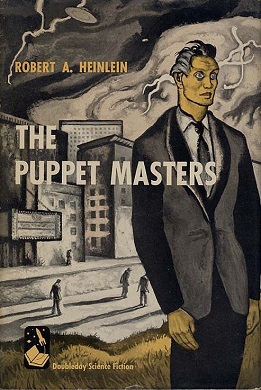
The Puppet Masters is a 1951 science fiction novel by American writer Robert A. Heinlein, in which American secret agents battle parasitic invaders from outer space. It was originally serialized in Galaxy Science Fiction.
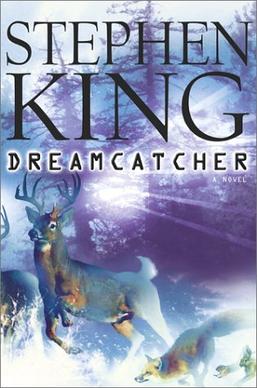
Dreamcatcher is a 2001 science fiction horror novel by American writer Stephen King, featuring elements of body horror, suspense and alien invasion. The book, written in cursive, helped the author recuperate from a 1999 car accident, and was completed in half a year. According to the author in his afterword, the working title was Cancer. His wife, Tabitha King, persuaded him to change the title. A film adaptation was released in 2003.
Grey aliens, also referred to as Zeta Reticulans, Roswell Greys or Grays, are purported extraterrestrial beings. They are frequent subjects of close encounters and alien abduction claims. The details of such claims vary widely. However, Greys are typically described as being human-like with small bodies, smooth, grey-colored skin; enlarged, hairless heads; and large, black eyes. The Barney and Betty Hill abduction claim, which purportedly took place in New Hampshire in 1961, popularized Grey aliens. Precursor figures have been described in science fiction and similar descriptions appeared in early accounts of the 1948 Aztec UFO hoax and later accounts of the 1947 Roswell UFO incident.
"Crouch End" is a horror story by Stephen King, set in the real-life North London district of Crouch End, originally published in New Tales of the Cthulhu Mythos (1980), and republished in a slightly different version in King's Nightmares & Dreamscapes collection (1993). It contains distinct references to the horror fiction of H. P. Lovecraft.

The communication with extraterrestrial intelligence (CETI) is a branch of the search for extraterrestrial intelligence (SETI) that focuses on composing and deciphering interstellar messages that theoretically could be understood by another technological civilization. The best-known CETI experiment of its kind was the 1974 Arecibo message composed by Frank Drake.
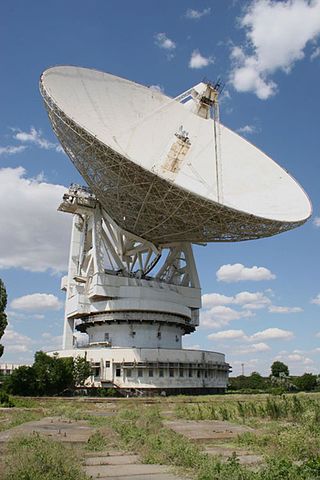
The Teen Age Message (TAM) was a series of interstellar radio transmissions sent from the Yevpatoria Planetary Radar to six solar-type stars during August–September 2001. The structure of the TAM was suggested by Alexander Zaitsev, Chief Scientist at Russia's Institute of Radio-engineering and Electronics. The message's content and target stars were selected by a group of teens from four Russian cities, who collaborated in person and via the Internet. Each transmission comprised three sections: a sounding, a live theremin concert, and digital data including images and text. TAM was humanity's fourth Active SETI broadcast and the first musical interstellar radio message.
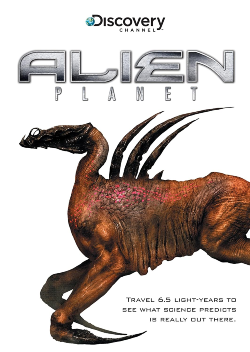
Alien Planet is a 2005 docufiction TV special created for the Discovery Channel. Based on the 1990 book Expedition by the artist and writer Wayne Barlowe, Alien Planet explores the imagined extraterrestrial life of the fictional planet Darwin IV in the style of a nature documentary. Although closely following Barlowe's depiction of Darwin IV, Alien Planet features a team of scientists and science fiction figures discussing Darwin IV as if it had actually been discovered. Among the people featured are Michio Kaku, Stephen Hawking, Jack Horner, James B. Garvin and George Lucas.

First contact is a common science fiction theme about the first meeting between humans and extraterrestrial life, or of any sentient species' first encounter with another one, given they are from different planets or natural satellites. The theme allows writers to explore such topics such as xenophobia, transcendentalism, and basic linguistics by adapting the anthropological topic of first contact to extraterrestrial cultures.
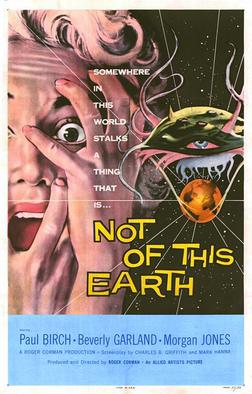
Not of This Earth is an independently made 1957 American black-and-white science fiction film produced and directed by Roger Corman, that stars Paul Birch, Beverly Garland, Morgan Jones, William Roerick, and Anna Lee Carroll. The film was written by Charles B. Griffith and Mark Hanna and was distributed by Allied Artists Pictures Corporation as a double feature with Attack of the Crab Monsters. Its theatrical release had a running time of 67 minutes, that was expanded to 70 minutes in 1962 for TV syndication.
"Corpus Earthling" is an episode of the original The Outer Limits television show. It first aired on 18 November 1963, during the first season.
"Counterweight" is an episode of the original The Outer Limits television show. It first aired on 26 December 1964, during the second season.
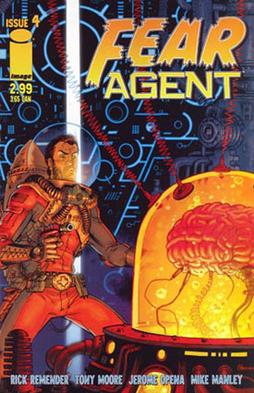
Fear Agent is an American science fiction comic book series written by Rick Remender with art by Tony Moore and Jerome Opena, who alternated on story arcs. The series was published by Dark Horse Comics from 2007 to 2018 and by Image Comics from 2005–2006 and currently from 2018.

The Pitt is a 1987 one-shot comic book written by John Byrne and Mark Gruenwald, and illustrated by Sal Buscema and Stan Drake. It was published by Marvel Comics as part of its New Universe line. The story depicts the total destruction of the city of Pittsburgh, Pennsylvania, and its immediate twelve-hour aftermath. The Pitt was the first graphic novel published for Marvel's New Universe series.

Fantastic Man is a 2007 Philippine television drama action fantasy series broadcast by GMA Network. The series is based on a 2003 Philippine film of the same title. Directed by Zoren Legaspi, it stars Mark Herras in the title role. It premiered on April 14, 2007. The series concluded on November 10, 2007, with a total of 31 episodes.

Out of the Darkness is a 1971 Thai science fiction musical action drama film directed by Chatrichalerm Yukol, about an invasion by extraterrestrial beings in Thailand. It was the first science fiction film made in Thailand, and was also the debut feature film by Chatrichalerm.

The Day the Earth Stopped is a 2008 American direct-to-DVD science fiction action horror film produced by independent studio The Asylum, directed by and starring C. Thomas Howell. It is a mockbuster of the 2008 remake of The Day the Earth Stood Still, which was released three days later. Howell stars as the protagonist, soldier Josh Myron, who witnesses the arrival of giant alien robots that threaten to destroy the Earth unless they are shown the value of human existence.
A formal description of an alien language in science fiction may have been pioneered by Percy Greg's Martian language in his 1880 novel Across the Zodiac, although already the 17th century book The Man in the Moone describes the language of the Lunars, consisting "not so much of words and letters as tunes and strange sounds", which is in turn predated by other invented languages in fictional societies, e.g., in Thomas More's Utopia.
Linguistics has an intrinsic connection to science fiction stories given the nature of the genre and its frequent use of alien settings and cultures. As mentioned in Aliens and Linguists: Language Study and Science Fiction by Walter E. Meyers, science fiction is almost always concerned with the idea of communication, such as communication with aliens and machines, or communication using dead languages and evolved languages of the future. Authors at times use linguistics and its theories as a tool for storytelling, as in Jack Vance's Languages of Pao, although technical terms are rarely used, and authors only go into as much detail as the reader will understand.

Archaeology, Anthropology, and Interstellar Communication is a 2014 collection of essays edited by Douglas Vakoch and published by NASA. The book is focused on the role that the humanities and social sciences, in particular anthropology and archaeology, play in the search for extraterrestrial intelligence (SETI). The seventeen essays are gathered into four sections, which respectively explore the history of SETI as a field; archaeological comparisons for human-alien communication, such as the difficulties of translating ancient languages; the inferential gap between humans and aliens, and the consequences this would have for communication and trade; and the potential nature of alien intelligences.













